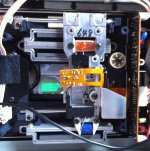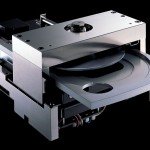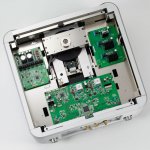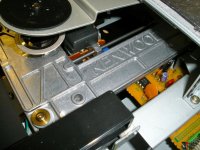Here's an interesting article (this is the raw text, no photos sadly) from Hifi Critic by Stan Curtis (designer of Cambridge Audio CD1, CD2, CD3 for example) on a failed project for a high-end CD player for B&W / SME.
http://www.stancurtis.com/PDFs/HiFi Critic 6.pdf
Interestingly the article also speaks of the sonic results of removing much of the digital filtering and also analogue filters, beneficial results to Stan Curtis's ears whilst not recommending it due to the nyquist images still being there..
http://www.stancurtis.com/PDFs/HiFi Critic 6.pdf
I recently came across odd components and some of the drawings and in the one shown here it can be seen that the player was built like a record turntable with a proper suspension; a lightweight platter with an oversized motor which locked the actual linear velocity solidly to the servo voltage; and, get this, a vacuum suction system to hold the disc firmly in place. Unusually the laser head was on top of the disc in the manner of a tone arm and at start up the arm moved across to the disc which was then scanned radially by the laser/optics assembly in a short stub arm. The whole assembly was very stable and measurements made on the servo system of the prototype showed that the focus corrections made were a fraction of those made on a conventional player. As a result of this and other design features this transport had extremely low reading errors so the processor’s error correction circuits could be almost entirely devoted to the errors caused in the process of moulding the disc.
Interestingly the article also speaks of the sonic results of removing much of the digital filtering and also analogue filters, beneficial results to Stan Curtis's ears whilst not recommending it due to the nyquist images still being there..
Last edited:
As I wrote, make a new SFP101N-16P and shut up believing and soft flavouring. Every bit of it can be bettered but it won't happen if you folks are batteling over non issues.
Servos sounds - can you hear it - yes if you put your ear to it - sh*t - do you usually stand in that position when listening to music? If not - no problem after a few feet away it is totally silent to your ear. So what? Still makes sounds? Sigh...
What I am not happy about with the SFP101N-16P is that it has too soft metals and to thin rods. For long time endurability it also have weak transport durability due to harsh metal against soft plastic.
But the transport itself is fantastic. I hope sincerely that whatever is created is compatible with the SFP101N-16P or many would be viewing the fact - buy the Shigaclone MKIII board. It's all about the money these days...
Regards
...agreed with all you say ...up to a point: the Shiga MKIII transport cannot do I2S ...if it could then it would be perfect.
😎
Hi NATDBERG,
I was authorized warranty for Tascam at the time. I am intimately familiar with those transports. What they prove is that if you throw enough money at a problem, you can make it work.
We had problems with the bearings and alignment with the VRDS mechanisms. It would have performed much better than it did using the normal light mass system. The CD-701 was one of my favorites using a KSS-151A laser head assy. They did well in studios, and that is what they were designed for. The unit you described on the bass cabinet likely had its tracking gain adjusted high. They were pretty good, but normally that good (unless the vibration was lower than you thought). If I ran across a CD-701 today, I would fix it up and use it.
Teac / Tascam in those days were heavily sales department driven. Some manufacturers (like Teac / Tascam) decided to go with whatever was seen to be an edge for sales blah-blah-blah. Pioneer made a lot of noise about their "stable platter" and it got some traction with consumers. They first said that the CD player was to replace the turntable. After that, they began to market turntable-like features (stable platter = heavy turntable). The average person could relate to that and so that direction worked for sales. But, never confuse a sales "feature" with what is mechanically and technically correct. Some of you are still taken in with this ploy. CEC even went as far as to make a CD player with a belt drive! Some of you who I met at Burning Amp 1 defended the belt drive strongly, so effective was the advertising.
Always remember false assumption #1. A CD player is not a turntable. They operate differently at a fundamental level and performance requirements diverge rapidly from that point further.
About filtering. You need it to be in place. The severity of the type of filter (order) is directly coupled with the sampling frequency. The higher that frequency is, the further out that filter can be, and them more gentle the slope can be. What is the worst case situation. You're going to love it. No oversampling, and no filter. If any of you really do understand the D to A process and sampling theory, you would never do this. Yet there are some of you standing up as experts that advocate this stupidity. Folks who follow this aren't stupid, they just don't have the right information and the NOS show is more attractive than the technical side of things. It's always more attractive to "buck the system" and to think some people know more than the folks who actually work in that field professionally and have had training. I find it painful to watch people being led down the garden path by self-proclaimed experts. If you don't believe the science, then go ask a mathematician.
-Chris
I was authorized warranty for Tascam at the time. I am intimately familiar with those transports. What they prove is that if you throw enough money at a problem, you can make it work.
We had problems with the bearings and alignment with the VRDS mechanisms. It would have performed much better than it did using the normal light mass system. The CD-701 was one of my favorites using a KSS-151A laser head assy. They did well in studios, and that is what they were designed for. The unit you described on the bass cabinet likely had its tracking gain adjusted high. They were pretty good, but normally that good (unless the vibration was lower than you thought). If I ran across a CD-701 today, I would fix it up and use it.
Teac / Tascam in those days were heavily sales department driven. Some manufacturers (like Teac / Tascam) decided to go with whatever was seen to be an edge for sales blah-blah-blah. Pioneer made a lot of noise about their "stable platter" and it got some traction with consumers. They first said that the CD player was to replace the turntable. After that, they began to market turntable-like features (stable platter = heavy turntable). The average person could relate to that and so that direction worked for sales. But, never confuse a sales "feature" with what is mechanically and technically correct. Some of you are still taken in with this ploy. CEC even went as far as to make a CD player with a belt drive! Some of you who I met at Burning Amp 1 defended the belt drive strongly, so effective was the advertising.
Always remember false assumption #1. A CD player is not a turntable. They operate differently at a fundamental level and performance requirements diverge rapidly from that point further.
About filtering. You need it to be in place. The severity of the type of filter (order) is directly coupled with the sampling frequency. The higher that frequency is, the further out that filter can be, and them more gentle the slope can be. What is the worst case situation. You're going to love it. No oversampling, and no filter. If any of you really do understand the D to A process and sampling theory, you would never do this. Yet there are some of you standing up as experts that advocate this stupidity. Folks who follow this aren't stupid, they just don't have the right information and the NOS show is more attractive than the technical side of things. It's always more attractive to "buck the system" and to think some people know more than the folks who actually work in that field professionally and have had training. I find it painful to watch people being led down the garden path by self-proclaimed experts. If you don't believe the science, then go ask a mathematician.
-Chris
I went to IFA fair in Berlin, spending a day in the area reserved for suppliers. Only one displayed boomboxes. None displayed OEM CD/DVD mechanisms.
One offered contact to some nonamers in China.
The CEO of an european company which does OEM for many High End CD told me, that Sanyo is the only brand left, that produces mechs for audio.
Sony, Philips (now Gibson) left the market. But Sanyo was aquired by Panasonic in 2011.
No hint on Panasonic Industrial that CD/DVD mechanismss are still produced for OEM.
I read that Teac/Tascam was the last one making them.
Are there no good quality transport mechanisms out there anymore?
Product: CD-6010 | TASCAM
The CD-6010 features the field-proven CD-5010B drive asembly - the same drive used in the TASCAM CD-9010 & CD-9010CF - our top Broadcasting models. The CD-6010 is the new standard of Broadcast, Installation, and Touring CD players.
I got to page 11 before posting, going back to read up on things.
Lots of interesting things in this thread.🙂
Is the CD-5010B nothing more than an ATAPI CD-ROM drive? No wonder it is so good. 🙂
CD-5010B » TEAC Industrial Products Division
CD-5010B » TEAC Industrial Products Division
Sarcasm?Is the CD-5010B nothing more than an ATAPI CD-ROM drive? No wonder it is so good. 🙂
CD-5010B » TEAC Industrial Products Division
Vela Audio - CD player
[Review] Vela Audio CD player, listening test
The transport is a Teac CD-5010B, an audio-oriented CD-Rom unit, used on every Audio Analogue CD player and on some professional CD players from Tascam.
Is this CD-Rom unit as good or better than other drives already mentioned?
I guess I do not need to explain that the Sanyo SFP-101N uses cheap Mabuchi Motors- like almost any of the current transports. And the Sanyo SFP-101N is not being produced either.
And now look at this, this is the goal: All magnetic, no gears, completetely serviceable:
What drive is that from?
Attachments
As far as I remember, the CD5010B is nothing but a Sanyo mechanism - But I am not sure.
@kac22i Drive is Sony BU-1 frpm CDP-502ES, very common in 1985. Then they cut corners
@kac22i Drive is Sony BU-1 frpm CDP-502ES, very common in 1985. Then they cut corners
What drive is that from?
That looks like a Sony BU-1E, I have this in my Sony 333ESD
The Teac players used the KSS-151A which is superficially similar but plastic. That photo is of a BU-1 I'm pretty sure. The KSS-190A is also similar but not exactly the same. I own examples of all three if any pictures would be helpful to this thread?
Here about the new VRDS - Neo Mecano VRDS-NEO Mechanism | Esoteric supporting all formats 😀
VRDS-NEO “VMK-3.5-20S” transport mechanism and the only player
Hp
VRDS-NEO “VMK-3.5-20S” transport mechanism and the only player
Hp
Attachments
Last edited:
I'm no expert, but the above looks good to me.Here about the new VRDS - Neo Mecano
RE: Teac/Tascam CD-5010B and the plastic case 5020...................
Welcome to SAKURA SYSTEM's new site.
home
Model 4704 PiTracer is temporarily out of production until Junji Kimura finishes re-configuring it with the new TEAC mechanism.
As I understand it, the 47 Laboratory's very expensive CD (and good) players were the inspiration behind these many mod/DIY threads.
I have no idea if 47 Labs is going to follow through, and which TEAC mechanism they are looking at. I assume they were attracted (as I was) to something still in production and not something they would have to salvage.
I am very interested in what this thread comes up with, other than another 2008 boombox salvage job.
EDIT:
ESOTERIC K-01 CD/SACD PLAYER
Full Reference Status
Equipment report
by Alan Taffel | Mar 28th, 2013
Esoteric K-01 CD/SACD Player | The Absolute Sound
and the K-01 has dropped to $19,500......................and improved DAC linearity through the use of more (eight versus four) parallel/differential AKM chipsets per channel.
Something in common with the $1,000 CD player I was looking at?
TASCAM CD-6010
AK4480 D/A Converters (manufactured by Asahi Kasei Microdevices)
Product: CD-6010 | TASCAM
he CD-6010 features the premium 32-bit stereo DAC AK4480 - made by the highly-regarded manufacturer Asahi Kasei Microdevices - chosen after rigorous audio testing. The AK4480's 32-bit digital filter ensures high-quality sound, and provides a wider dynamic range and lower distortion factor.
PingPing over at Audio Circles had the TASCAM CD-6010 last year, the sound never flushed out enough for him, not even after +350 hours of use, so he moved on.
Still interesting to me to see some of the same suppliers in pro/mid-fi and upper end equipment.
Last edited:
This was an interesting find.
Esoteric TEAC UX-3 SACD DVD CD
https://app.audiogon.com/listings/c...d-cd-2015-11-18-digital-92694-ladera-ranch-ca
What a horrible thing for some people to do.
Reminds me of the story about the mid 1960's Shelby Mustang's Hertz used to rent out. People were drag racing them or worse, pulling the engines out and replacing them with stock engines.
Esoteric TEAC UX-3 SACD DVD CD
https://app.audiogon.com/listings/c...d-cd-2015-11-18-digital-92694-ladera-ranch-ca
Esoteric (TEAC) UX-3 (MSRP: $8,500): The DVD/SACD/CD Universal High-End Player model that is rarely found on the Market as it playings all format, and outputs all formats of analog and digital audio while providing exceptional video output on the DVI/D1/D2 output(s). This unit was Built in March 2006, and has been handled ever so gently and meticulously. I am it's original owner and have the original authorized dealer's receipt for my purchase dated January 2012. It comes with original power cord and remote control. It is in flawless cosmetic and working condition.
Note:
Due to the delicate nature of electronics, and some unscrupulous people removing and replacing parts, there will be No returns on this item !
This player will be shipped in it's current 100% working condition !
What a horrible thing for some people to do.
Reminds me of the story about the mid 1960's Shelby Mustang's Hertz used to rent out. People were drag racing them or worse, pulling the engines out and replacing them with stock engines.
Hi Mike P,
The KSS-151A seems to be dimensionally stable, so going with the other materials might offer minimal benefits, yet cost more.
Hi HpW,
That one is a no-go from my stand point. Adding mass to a rotating system is only a good idea for turntables. CD players operate entirely differently. You want to decrease the rotating mass as much as you can. The much faster rotation of a CD allows the CD to stabilize itself. Compare 33 1/3 or 45 constant RPM to a CD where the center rotates closer to 500 rpm, falling to 300 rpm or so near the outside tracks. The big takeaway there is the a record is a constant angular velocity, the CD is a constant linear velocity (rotational/angular speed changes). Since rotating mass tends to fight changes in angular velocity adding to it in a CD player makes the disc motor less able to correct for variations in rotational speed. The rotational velocity in a CD must be able to change quickly in order to spin up to read the TOC, or to change tracks. Turntables historically do not do this (the Nakamichi Dragon TT might) to compensate for off-center media.
Mounting laser heads upside down seems problematic for me also. The suspensions are designed to cope with gravity pulling the lens down, not up with respect to the head assy.
-Chris
The KSS-151A seems to be dimensionally stable, so going with the other materials might offer minimal benefits, yet cost more.
Hi HpW,
That one is a no-go from my stand point. Adding mass to a rotating system is only a good idea for turntables. CD players operate entirely differently. You want to decrease the rotating mass as much as you can. The much faster rotation of a CD allows the CD to stabilize itself. Compare 33 1/3 or 45 constant RPM to a CD where the center rotates closer to 500 rpm, falling to 300 rpm or so near the outside tracks. The big takeaway there is the a record is a constant angular velocity, the CD is a constant linear velocity (rotational/angular speed changes). Since rotating mass tends to fight changes in angular velocity adding to it in a CD player makes the disc motor less able to correct for variations in rotational speed. The rotational velocity in a CD must be able to change quickly in order to spin up to read the TOC, or to change tracks. Turntables historically do not do this (the Nakamichi Dragon TT might) to compensate for off-center media.
Mounting laser heads upside down seems problematic for me also. The suspensions are designed to cope with gravity pulling the lens down, not up with respect to the head assy.
-Chris
If that's how you use CD's then great, but what about us lazy old farts who don't even use the remote and just put a CD in and hit play?The rotational velocity in a CD must be able to change quickly in order to spin up to read the TOC, or to change tracks.
At most I might press the skip button to advance to let's say the 4th track, but play out the rest of the CD in order (just as I would with a record player/turntable).
In the situation I described above a high mass system would work great (because you just keep on rolling along), plus the benefits which come with the extra mass.
It's a matter of making choices.
There is an Esoteric combo on A-gon right now which lists for almost $100,000, somebody thought it was a good idea - just say'n.
EDIT: Yet another way to cook your eggs.
NuForce CDP-8 CD player
By Wes Phillips • Posted: Nov 21, 2010
Read more at NuForce CDP-8 CD player | Stereophile.com
NuForce CDP-8 CD player | Stereophile.com
The interesting wrinkle in the CDP-8's design is its constant angular-velocity transport, which runs at a single speed, filling the player's buffer with data. (Normally, a CD player constantly varies its speed, from 500rpm at the innermost data spiral to 200rpm at the outermost data spiral, in order to provide the DAC with a steady datastream.) The transport's laser is DSP-controlled, which NuForce says reduces jitter and increases the datastream's accuracy. The data coming from the buffer are resynchronized by an onboard master clock. NuForce claims that the CDP-8's jitter is "practically non-existent."...................
And it costs $1450
Last edited:
Hi kach22i,
Depending on how much mass is on the system, skipping up a track or 2 could cause the CD to lose lock on the CD. Lazy old fart or not has nothing to do with the actual process of playing a CD.
I operate mine much the same way as you do. But why design a system that fights itself and reduces performance for zero gain? You seem to be under the impression that normal CD players suffer from a speed stability problem - but they don't. There isn't one bit of performance gain afforded by any "stable platter" system. This is the core problem, you have been lied to through advertising. You are still thinking along the lines of a turntable. The Thorens I use has a 2.5 kg platter, works fantastically well. But this table doesn't play CDs very well! 🙂
It is both less expensive and better performance using the standard, magnetic clamp system with low mass. The stable platter actually adds to data errors, never reducing them. Once you can accept that CD players and record players are fundamentally different in the way they work, you'll understand better.
-Chris
Depending on how much mass is on the system, skipping up a track or 2 could cause the CD to lose lock on the CD. Lazy old fart or not has nothing to do with the actual process of playing a CD.
I operate mine much the same way as you do. But why design a system that fights itself and reduces performance for zero gain? You seem to be under the impression that normal CD players suffer from a speed stability problem - but they don't. There isn't one bit of performance gain afforded by any "stable platter" system. This is the core problem, you have been lied to through advertising. You are still thinking along the lines of a turntable. The Thorens I use has a 2.5 kg platter, works fantastically well. But this table doesn't play CDs very well! 🙂
It is both less expensive and better performance using the standard, magnetic clamp system with low mass. The stable platter actually adds to data errors, never reducing them. Once you can accept that CD players and record players are fundamentally different in the way they work, you'll understand better.
-Chris
The rotation/read speed is about keeping the FIFO buffer approximately half full. Low mass means faster/low power servo control.
The best way to improve CD playback is handle them correctly. No bending or scratching please.
The best way to improve CD playback is handle them correctly. No bending or scratching please.
Last edited:
- Home
- Source & Line
- Digital Source
- Quality CD-Mechanisms are long gone - let us build one ourselves!



